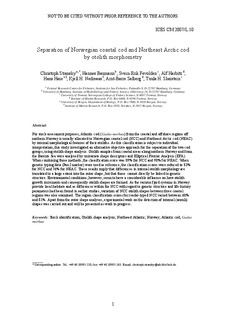| dc.contributor.author | Stransky, Christoph | |
| dc.contributor.author | Baumann, Hannes | |
| dc.contributor.author | Fevolden, Svein-Erik | |
| dc.contributor.author | Harbitz, Alf | |
| dc.contributor.author | Høie, Hans | |
| dc.contributor.author | Nedreaas, Kjell Harald | |
| dc.contributor.author | Salberg, Arnt-Børre | |
| dc.contributor.author | Skarstein, Tuula H. | |
| dc.date.accessioned | 2012-02-07T08:54:32Z | |
| dc.date.available | 2012-02-07T08:54:32Z | |
| dc.date.issued | 2007 | |
| dc.identifier.citation | This report is not to be quoted without prior consultation with the General Secretary. | no_NO |
| dc.identifier.uri | http://hdl.handle.net/11250/103240 | |
| dc.description.abstract | For stock assessment purposes, Atlantic cod (Gadus morhua) from the coastal and offshore regions off
northern Norway is usually allocated to Norwegian coastal cod (NCC) and Northeast Arctic cod (NEAC)
by internal morphological features of their otoliths. As this classification is subject to individual
interpretation, this study investigated an alternative objective approach for the separation of the two cod
groups, using otolith shape analysis. Otolith samples from coastal areas along northern Norway and from
the Barents Sea were analysed by univariate shape descriptors and Elliptical Fourier Analysis (EFA).
When combining those methods, the classification score was 89% for NCC and 90% for NEAC. When
genetic typing data (Pan I marker) were used as reference, the classification scores were reduced to 83%
for NCC and 76% for NEAC. These results imply that differences in internal otolith morphology are
translated to a large extent into the outer shape, but that those cannot directly be linked to genetic
structure. Environmental conditions, however, seem to have a considerable influence on how otolith
growth increments and consequently otolith shapes are formed. As the various fjord systems in Norway
provide local habitats and as differences within the NCC with regard to genetic structure and life-history
parameters had been found in earlier studies, variation of NCC otolith shapes between three coastal
regions was also examined. The region classification scores for reader-typed NCC varied between 60%
and 81%. Apart from the outer shape analyses, experimental work on the detection of internal (annuli)
shapes was carried out and will be presented as work in progress.
Keywords: Stock identification; Otolith shape analysis; Northeast Atlantic; Norway; Atlantic cod; Gadus
morhua | no_NO |
| dc.language.iso | eng | no_NO |
| dc.publisher | ICES | no_NO |
| dc.relation.ispartofseries | ICES CM documents;2007/L:10 | |
| dc.subject | coastal cod | no_NO |
| dc.subject | kysttorsk | no_NO |
| dc.subject | arctic cod | no_NO |
| dc.subject | arktisk torsk | no_NO |
| dc.subject | stock assessment | no_NO |
| dc.subject | bestandsberegning | no_NO |
| dc.title | Separation of Norwegian coastal cod and Northeast Arctic cod by otolith morphometry | no_NO |
| dc.type | Working paper | no_NO |
| dc.subject.nsi | VDP::Agriculture and fishery disciplines: 900::Fisheries science: 920::Resource biology: 921 | no_NO |
| dc.source.pagenumber | 28 s. | no_NO |
